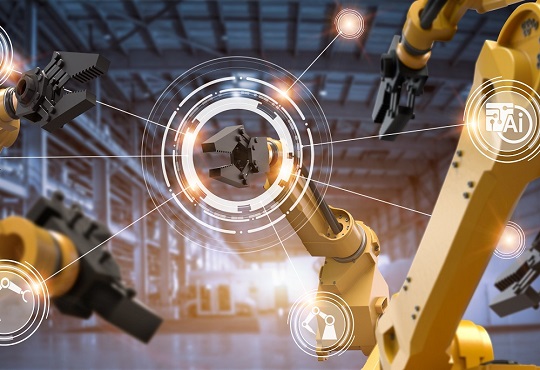
How Industrial IoT is Revolutionizing Manufacturing
Janifha Evangeline | Sunday, 09 April 2023, 21:53 IST

Over the past ten years, the Internet of Things (IoT) has experienced tremendous growth. The consumer domain is IoT's most evident area of concentration. But Industrial IoT (IIoT) is arguably this new technology's biggest supporter. Industrial IoT, also known as IIoT or Industry 4.0, is an expansion of IoT in the manufacturing sector. Automation is made possible throughout the whole industrial complex thanks to IIoT, which connects machines and industrial equipment to a secure network. IIoT makes use of a combination of SCADA, Big Data Analytics, M2M connectivity, and other industrial machinery of the same nature.
Notwithstanding all the excitement around industrial IoT, it would be wise to issue a warning regarding a few issues that the sector is addressing. The operability of older and more modern systems may not be compatible, and security breaches are a constant concern. The existing environment, however, demonstrates robust construction and improved system adaptability. Although the magic solution that big manufacturers have been searching for could be found in industrial IoT, there are a few challenges that arise in adopting IIoT in the manufacturing industry
Challenges in adopting IIoT in the Manufacturing industry
Interoperability
The production procedures used in various industries vary. For the industrial sectors, neither standards nor sets of smart industrial sensors are available. For instance, data transfer across devices from various vendors within an ecosystem could be difficult. More device interoperability has been made possible by standards like Zigbee and Thread, but no comparable standards have been established for Industry 4.0. To ensure the business unit's interoperability based on current procedures, OEMs and SMEs will need to modify/digitize their operations.
Security
Securing smart technology is useless if it lacks a network of connections. Yet, there are dangers involved with networking industry-grade computers. It might jeopardize the safety of workers and equipment by creating vulnerabilities and causing production processes to malfunction. To safeguard against cyber-attacks, Industry 4.0 OEMs must have the strongest and most secure environment imaginable.
Insufficient expertise among industry makers
Several industry skills are either insufficient or difficult to locate because IIoT is still in its early phases. It can be difficult to coordinate hardware, integrate data from diverse sources, and realize manufacturers' goals. Due to a lack of understanding and significant expenditure needs, Industry 4.0 technology will be challenging for small businesses to adopt.
Lack of Proven Technology
The mechanism or sensors in a smart manufacturing facility must be able to detect and share data from one machine to another. Industry-grade sensors and other smart technology are needed for this. There isn't a wide selection of smart equipment and sensors available right now. However, creating industry-grade sensors necessitates considerable training and simulation inside the ecosystem, which can be challenging, particularly for businesses with limited resources.
How IIoT is addressing these challenges
With a CAGR of 7.4% over the projected period, the industrial IoT (IIoT) market for devices & technologies is anticipated to increase from USD 77.3 billion to USD 110.6 billion by 2025. Let's look at some key areas to better understand how Industrial IoT is helping the manufacturing sector.
Asset management
Consider a factory that is producing a product. The operator must regularly check the product's progress, adjust the motor's control based on production timings, and monitor entry and exit points to regulate output. It would be advantageous in this situation to minimize human involvement and track the assets carefully. With the use of IIoT, smart industrial systems may manage workflow, records, and production in accordance with demand-supply requirements, track asset locations with smart sensors, and monitor those requirements.
Predictive Analytics
Manufacturers may more effectively track the status of their equipment, calculate the time needed to attain specific milestones and keep track of individual machine maintenance needs by implementing IIoT. Engineers can develop a mitigation strategy and find the issue's core cause with the use of predictive analytics technologies, which can also provide far earlier failure warnings. The production line will have more data as we advance in this ecosystem, increasing visibility to deal with complicated events and resulting in a more reliable system.
Effective and Productive Process
In the manufacturing sector, mechanical equipment requires routine servicing and maintenance. Unexpected equipment damage can disrupt production schedules and result in time and resource waste. By maintaining the equipment before it breaks, IoT-assisted production can reduce production downtime. When analytics are improved, production lines will eventually experience higher productivity and better decision-making.
Use of Smart Manufacturing Solution
A smart manufacturing solution would offer asset failure reports and aid in the phase-wise management of production units. Industrial motor control and speed diagnostics will also be supported by this solution. To track and control manufacturing remotely, this solution would give a cloud interface.
Safety Operations
Industrial space equipment can be dangerous, especially if it is not frequently maintained. By keeping an eye out for potentially harmful equipment failures and providing floor-wide notifications in the event of a potentially hazardous event, IIoT automation units can assist ensure the safety of personnel.
Numerous manufacturing firms have started devoting time and resources to the creation of intelligent IT-driven production solutions. Using benefits like asset management, predictive analytics, effective and productive processes, and safety operations is possible for industrial users thanks to the implementation of Industry 4.0. Even while IIoT has unquestionably demonstrated its usefulness, manufacturers, and businesses still face a number of adoption obstacles.
CIO Viewpoint
Artificial Intelligence & The Disruptive Chatbot
By Vishal Sinha, President & CIO, Tranzlease Holdings
IoT: Technology Trends to Watch Out for in 2021
By Sudeep Agrawal, AVP and Head IT, ReNew Power
Reskilling IT with IOT, Cloud & AI
By Uttam Kumar, Head - IT Innovations & New Technology, Aircel
CXO Insights
4 Must Have IT Security Skill sets To Counter...
By Sunil Sharma, Managing Director - Sales, India & SAARC, Sophos
How Low-Code Is Transforming The Future Of Work...
By Deepak Pargaonkar, VP - Solution Engineering, Salesforce
The Path To Managing Data As An Asset








.jpg)
.jpg)
.jpg)
.jpg)

.jpg)
.jpg)




